wheel VOLKSWAGEN TRANSPORTER 1990 T4 / 4.G Owner's Manual
[x] Cancel search | Manufacturer: VOLKSWAGEN, Model Year: 1990, Model line: TRANSPORTER, Model: VOLKSWAGEN TRANSPORTER 1990 T4 / 4.GPages: 165, PDF Size: 24.87 MB
Page 75 of 165
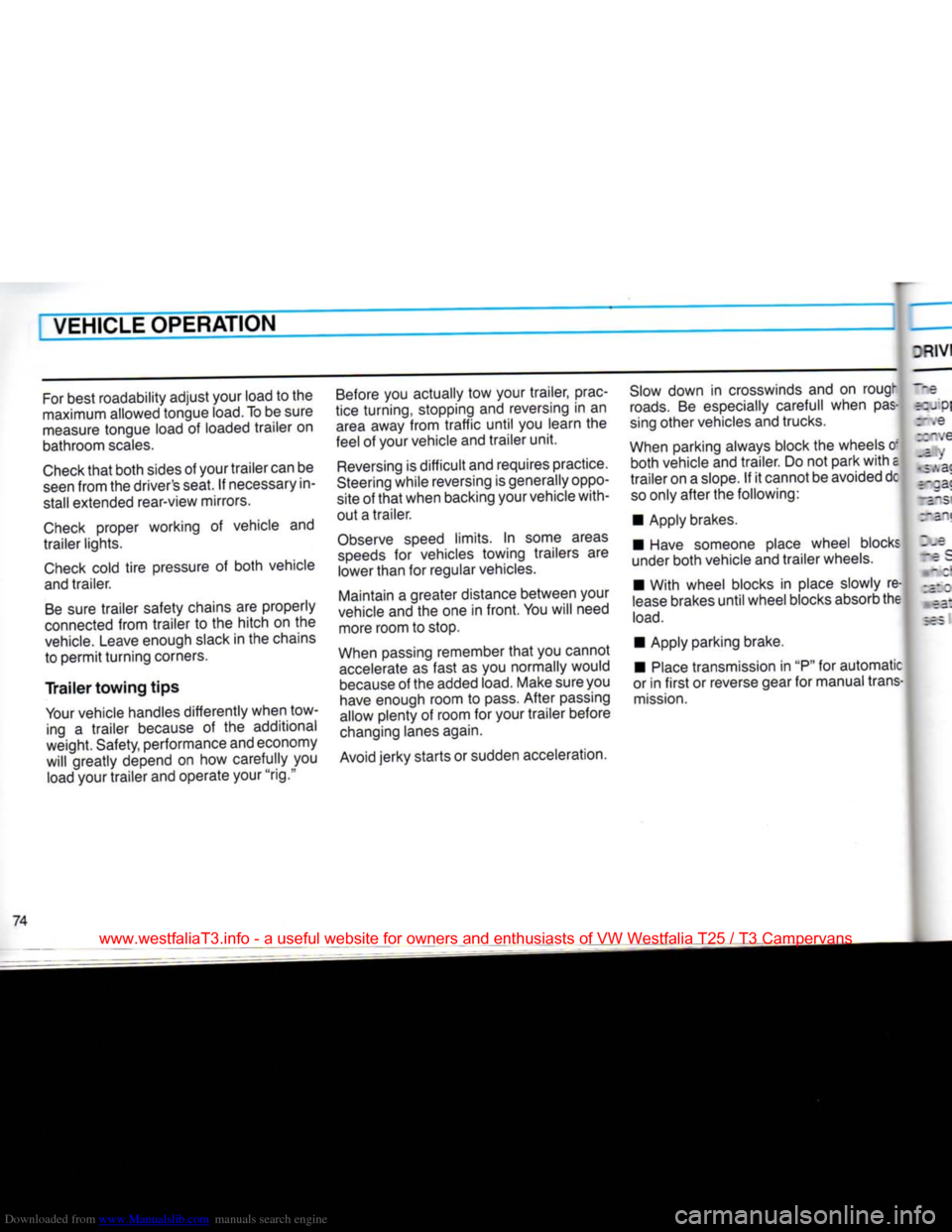
Downloaded from www.Manualslib.com manuals search engine
VEHICLE OPERATION
For
best roadability adjust your load to the
maximum allowed tongue load. To be sure
measure
tongue load of loaded trailer on
bathroom
scales.
Check
that
both sides of your trailer can be
seen
from the driver's seat. If necessary in
stall extended rear-view mirrors.
Check
proper working of vehicle and
trailer lights.
Check
cold
tire
pressure of both vehicle
and
trailer.
Be
sure trailer safety chains are properly
connected
from trailer to the hitch on the
vehicle.
Leave enough slack in the chains
to permit turning corners.
Trailer
towing
tips
Your
vehicle handles differently when tow ing a trailer because of the additional
weight. Safety, performance and economy
will greatly depend on how carefully you
load
your trailer and operate your "rig."
Before
you actually tow your trailer, prac
tice turning, stopping and reversing in an
area
away from
traffic
until
you learn the
feel of your vehicle and trailer
unit.
Reversing
is
difficult
and requires practice.
Steering
while reversing is generally oppo
site of
that
when backing your vehicle with
out a trailer.
Observe
speed limits. In some areas
speeds
for vehicles towing trailers are lower than for regular vehicles.
Maintain a greater distance between your
vehicle
and the one in
front.
You will need more room to stop.
When
passing remember
that
you cannot
accelerate
as fast as you normally would
because
of the added load. Make sure you
have
enough room to
pass.
After passing
allow plenty of room for your trailer before
changing
lanes again.
Avoid
jerky starts or sudden acceleration.
Slow
down in crosswinds and on rougi"
roads.
Be especially carefull when
pas
sing
other vehicles and trucks.
When
parking always block the wheels o: both vehicle and trailer. Do not park
with
a
trailer on a slope. If it cannot be avoided dc
so
only after the following:
• Apply brakes.
• Have someone place wheel blocks
under both vehicle and trailer wheels.
• With wheel blocks in place slowly re
lease
brakes
until
wheel blocks absorb the
load.
• Apply parking brake.
•
Place
transmission in
"P"
for automatic
or in
first
or reverse gear for manual trans
mission.
74
www.westfaliaT3.info - a useful website for owners and enthusiasts of VW Westfalia T25 / T3 Campervans
Page 76 of 165
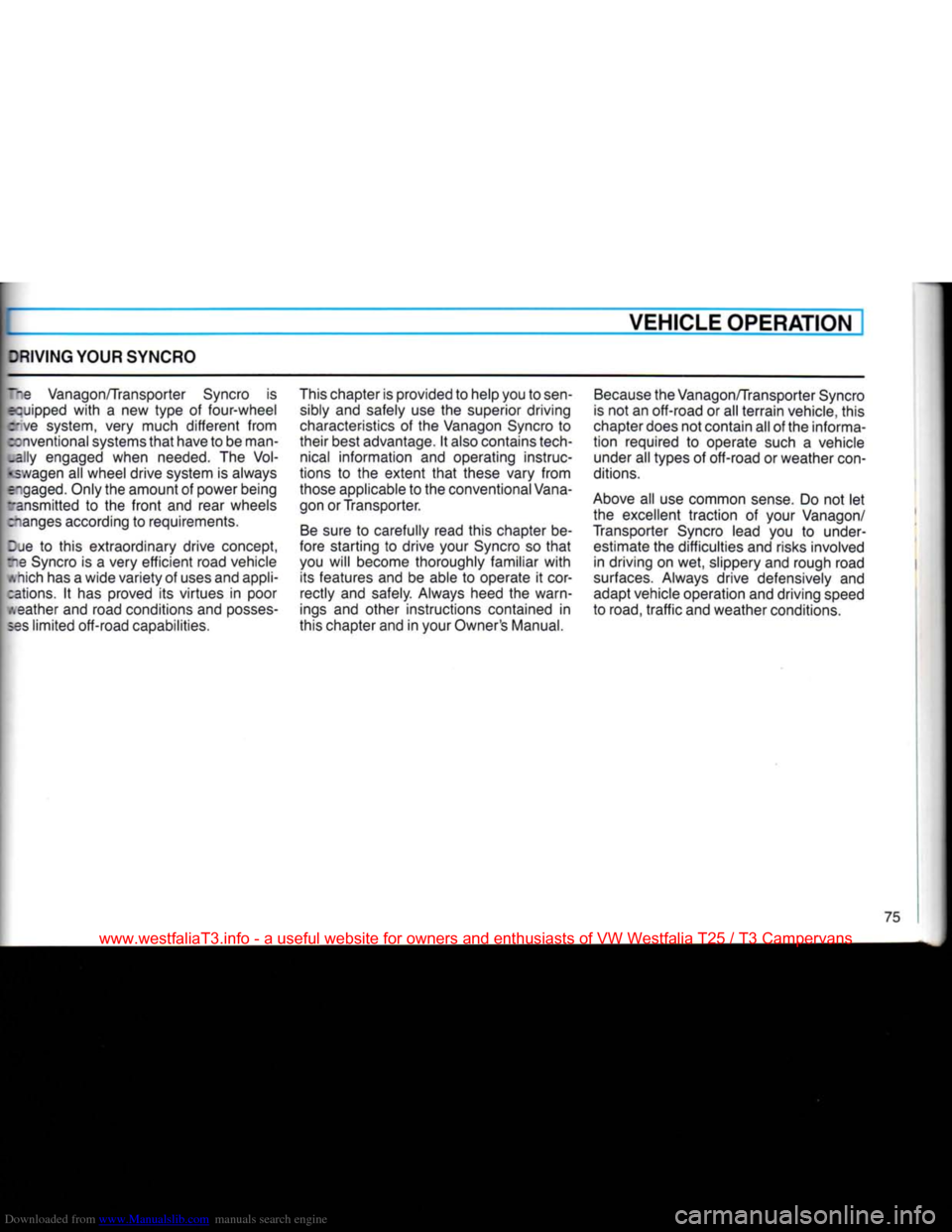
Downloaded from www.Manualslib.com manuals search engine
VEHICLE
OPERATION
IVING
YOUR
SYNCRO
me Vanagon/Transporter Syncro is
quipped
with
a new type of four-wheel :'>/e system, very much
different
from
rcnventional systems
that
have to be man- -=i!y engaged when needed. The
Vol
kswagen all wheel drive system is always
e-gaged.
Only the amount of power being
-ansmitted to the
front
and rear wheels
:~anges
according to requirements.
Cue
to this extraordinary drive concept,
:~e
Syncro is a very efficient road vehicle I
nich
has a wide variety of
uses
and appli-
:ations. It has proved its virtues in poor Bather and road conditions and
posses
ses
limited off-road capabilities.
This
chapter is provided to help you to
sen
sibly and safely use the superior driving
characteristics of the Vanagon Syncro to
their best advantage. It also contains tech
nical
information and operating instruc
tions to the extent
that
these vary
from
those applicable to the conventional
Vana
gon or Transporter.
Be
sure to carefully read this chapter be
fore starting to drive your Syncro so
that
you
will
become thoroughly familiar
with
its features and be able to operate it cor
rectly and safely. Always heed the warn
ings and other instructions contained in
this chapter and in your Owner's
Manual.
Because
the Vanagon/Transporter Syncro
is
not an off-road or all terrain vehicle, this
chapter does not contain all of the informa
tion
required to operate such a vehicle under all types of off-road or weather
con
ditions.
Above
all use common
sense.
Do not let the excellent traction of your Vanagon/
Transporter Syncro lead you to under estimate the difficulties and risks involved in driving on wet, slippery and rough road
surfaces.
Always drive defensively and
adapt vehicle operation and driving speed
to road,
traffic
and weather conditions.
www.westfaliaT3.info - a useful website for owners and enthusiasts of VW Westfalia T25 / T3 Campervans
Page 77 of 165
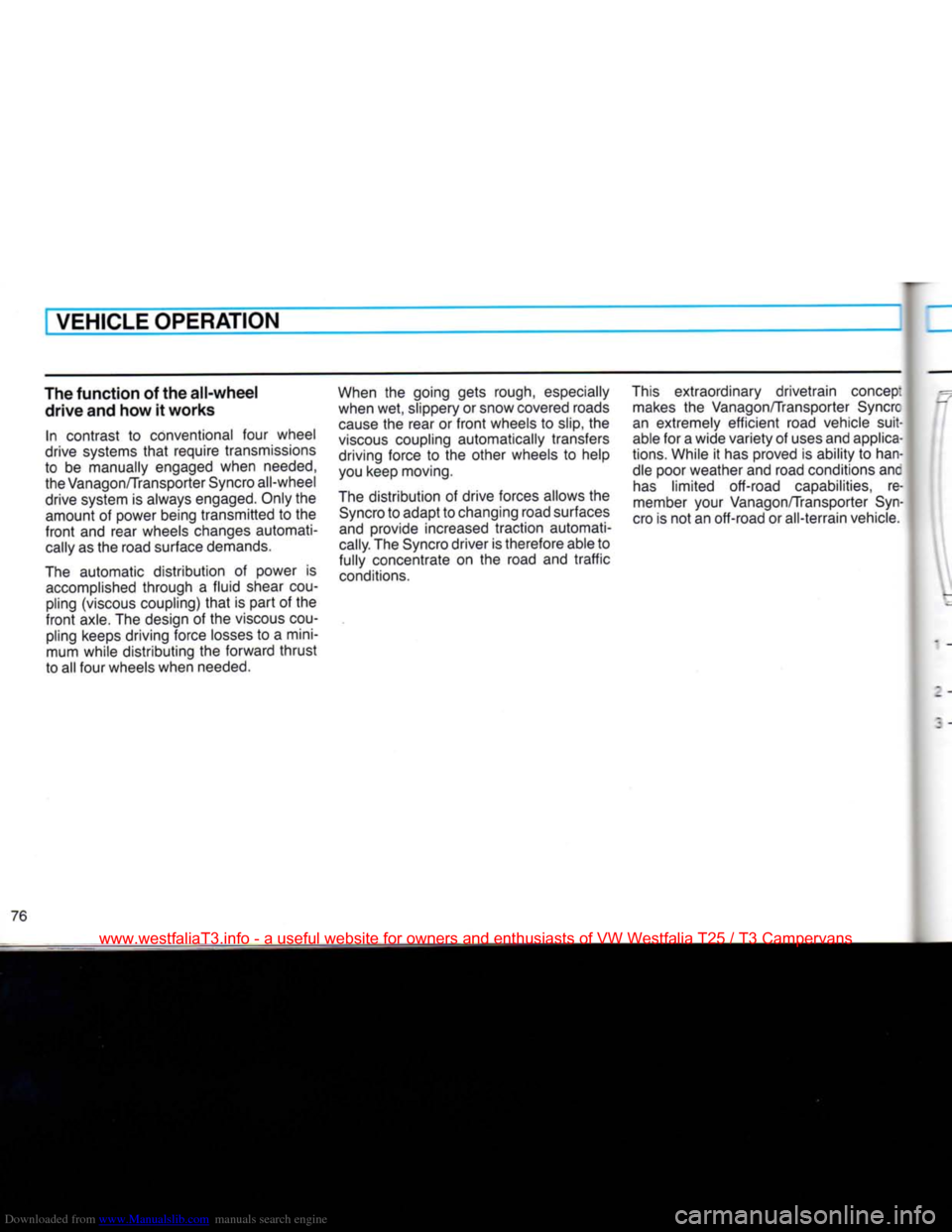
Downloaded from www.Manualslib.com manuals search engine
VEHICLE
OPERATION
The
function
of the
all-wheel
drive
and how it
works
In contrast to conventional four wheel
drive systems
that
require transmissions
to be manually engaged when needed,
the Vanagon/Transporter Syncro all-wheel
drive system is always engaged. Only the
amount of power being transmitted to the
front
and rear wheels changes automati
cally
as the road surface demands.
The automatic distribution of power is
accomplished
through a
fluid
shear
cou
pling (viscous coupling)
that
is
part
of the
front
axle. The design of the viscous
cou
pling keeps driving force losses to a mini
mum while distributing the forward
thrust
to all four wheels when needed. When the going gets rough, especially
when wet, slippery or snow covered roads
cause
the rear or
front
wheels to slip, the
viscous
coupling automatically transfers driving force to the other wheels to help
you keep moving.
The distribution of drive forces allows the
Syncro
to adapt to changing road surfaces
and provide increased traction automati
cally.
The Syncro driver is therefore able to
fully
concentrate on the road and
traffic
conditions.
This
extraordinary drivetrain concep:
makes
the Vanagon/Transporter Syncrc
an extremely efficient road vehicle suit
able for a wide variety of uses and applica
tions. While it has proved is ability to han
dle poor weather and road conditions anc
has
limited off-road capabilities, re
member your Vanagon/Transporter
Syn
cro is not an off-road or all-terrain vehicle.
76
www.westfaliaT3.info - a useful website for owners and enthusiasts of VW Westfalia T25 / T3 Campervans
Page 79 of 165
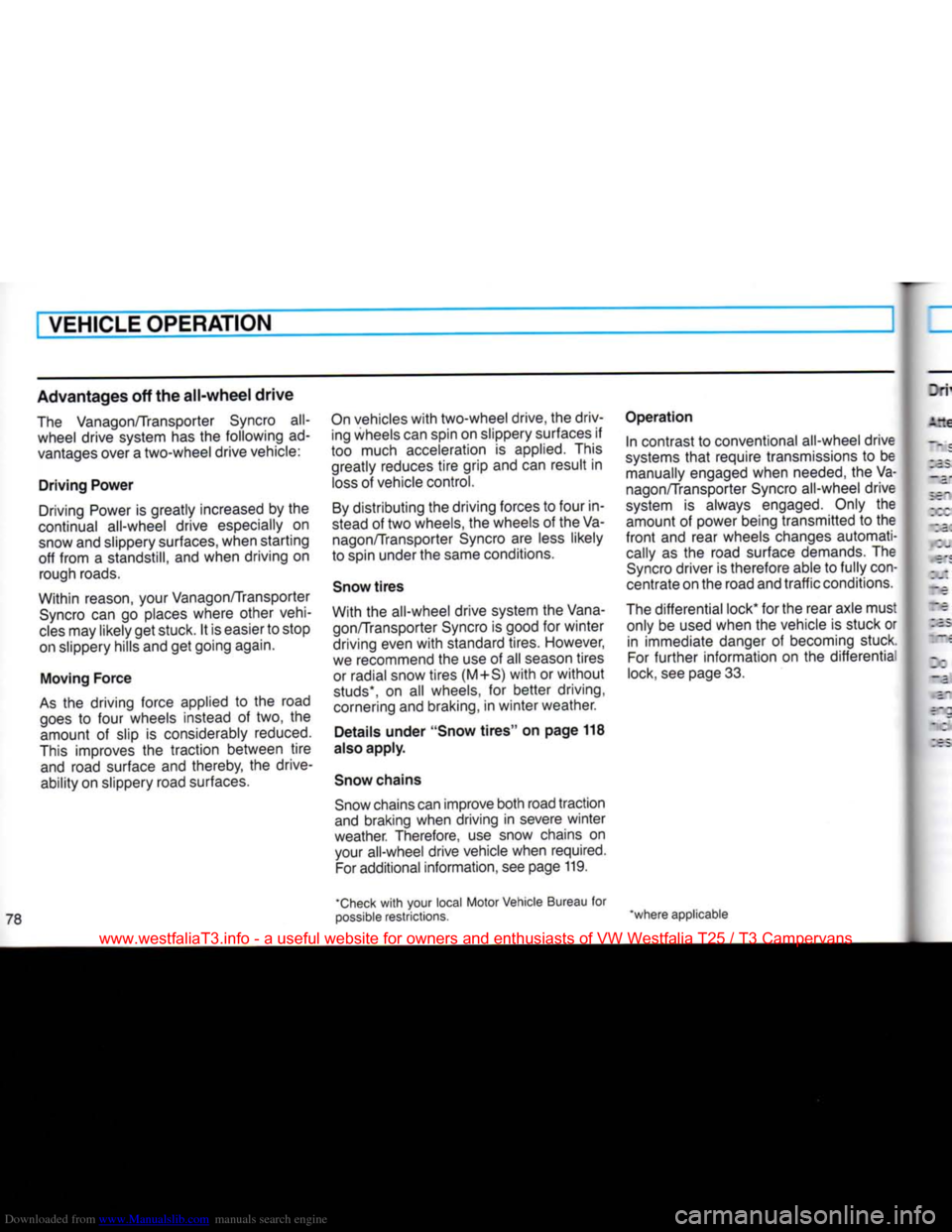
Downloaded from www.Manualslib.com manuals search engine
VEHICLE OPERATION
Advantages off the all-wheel drive
The Vanagon/Transporter Syncro
all-
wheel drive system
has the
following
ad
vantages over
a
two-wheel drive vehicle:
Driving Power
Driving Power
is
greatly increased
by the
continual all-wheel drive especially
on
snow
and
slippery surfaces, when starting
off from
a
standstill,
and
when driving
on
rough roads.
Within reason, your Vanagon/Transporter Syncro
can go
places where other
vehi
cles
may
likely
get
stuck.
It is
easier
to
stop
on slippery hills
and get
going again.
Moving Force
As
the
driving force applied
to the
road goes
to
four wheels instead
of two, the
amount
of
slip
is
considerably reduced.
This improves
the
traction between tire and road surface
and
thereby,
the
drive-
ability
on
slippery road surfaces. On vehicles with two-wheel drive,
the
driv
ing wheels
can
spin
on
slippery surfaces
if
too much acceleration
is
applied. This
greatly reduces tire grip
and can
result
in
loss
of
vehicle control.
By distributing
the
driving forces
to
four
in
stead
of two
wheels,
the
wheels
of the
Va nagon/Transporter Syncro
are
less likely
to spin under
the
same conditions.
Snow tires
With
the
all-wheel drive system
the
Vana gon/Transporter Syncro
is
good
for
winter
driving even with standard tires. However,
we recommend
the use of all
season tires
or radial snow tires (M
+
S) with
or
without
studs*,
on all
wheels,
for
better driving,
cornering
and
braking,
in
winter weather.
Details under "Snow tires"
on
page
118
also apply.
Snow chains
Snow chains can improve both road traction
and braking when driving
in
severe winter
weather. Therefore,
use
snow chains
on
your all-wheel drive vehicle when required. For additional information,
see
page
119.
Operation
In contrast
to
conventional all-wheel drive
systems that require transmissions
to be
manually engaged when needed,
the Va
nagon/Transporter Syncro all-wheel drive
system
is
always engaged. Only
the
amount
of
power being transmitted
to the
front
and
rear wheels changes automati cally
as the
road surface demands.
The
Syncro driver
is
therefore able
to
fully
con
centrate
on the
road and traffic conditions.
The differential lock*
for the
rear axle must only
be
used when
the
vehicle
is
stuck
or
in immediate danger
of
becoming stuck. For further information
on the
differential
lock,
see
page
33.
78 "Check with your local Motor Vehicle Bureau
for
possible restrictions.
'where applicable
www.westfaliaT3.info - a useful website for owners and enthusiasts of VW Westfalia T25 / T3 Campervans
Page 80 of 165
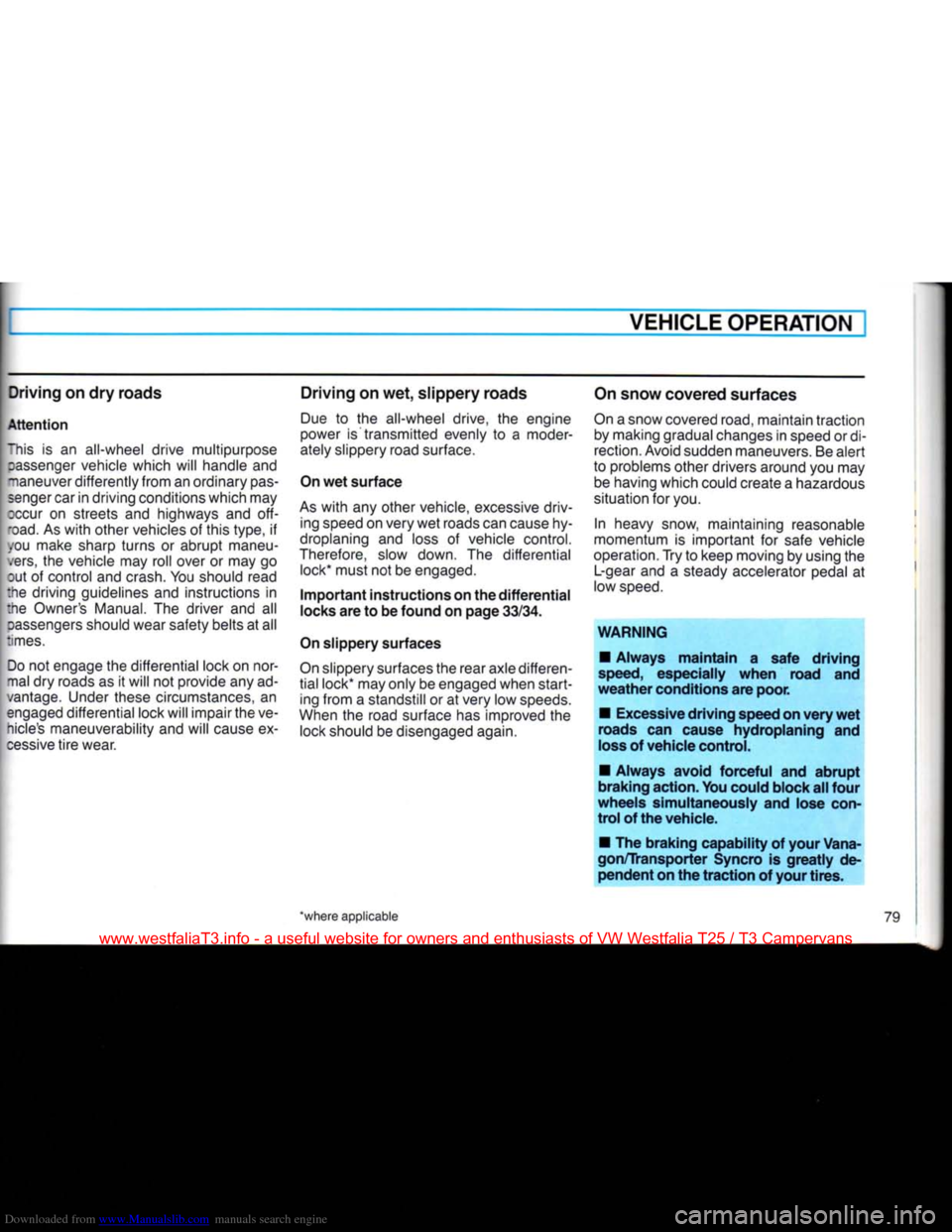
Downloaded from www.Manualslib.com manuals search engine
-
VEHICLE
OPERATION
Driving on dry roads
Attention
"his
is an
all-wheel drive multipurpose
rassenger
vehicle which
will
handle
and
maneuver
differently
from
an ordinary
pas
senger
car in driving conditions which may
occur
on
streets
and
highways
and off-
'oad.
As
with
other vehicles
of
this type,
if
you make sharp turns
or
abrupt maneu
vers,
the
vehicle
may
roll over
or
may
go
kit
of
control and
crash.
You should read
:he driving guidelines
and
instructions
in
the Owner's
Manual.
The
driver
and all
oassengers
should wear safety belts
at all
times.
Do
not
engage
the
differential lock on nor
mal
dry
roads
as it
will
not
provide any ad
vantage. Under these circumstances,
an
engaged differential lock
will
impair the ve-
nicle's
maneuverability and
will
cause
ex
cessive
tire
wear.
Driving on wet, slippery roads
Due
to the
all-wheel drive,
the
engine
power
is
transmitted evenly
to a
moder
ately slippery road surface.
On
wet surface
As
with
any
other vehicle, excessive driv ing speed on very wet roads can cause hy
droplaning
and
loss
of
vehicle control.
Therefore, slow down.
The
differential lock* must
not be
engaged.
Important
instructions
on
the
differential
locks
are to be found on page
33/34.
On
slippery surfaces
On
slippery surfaces the rear axle differen
tial
lock may only be engaged when
start
ing
from
a
standstill
or at
very low
speeds.
When
the
road surface has improved
the
lock should
be
disengaged again. On
snow covered surfaces
On
a
snow covered road, maintain traction by making gradual changes
in
speed
or
di
rection. Avoid sudden maneuvers. Be alert
to problems other drivers around you may be having which could create
a
hazardous
situation
for
you.
In heavy snow, maintaining reasonable
momentum
is
important
for
safe vehicle
operation. Try
to
keep moving
by
using
the
L-gear and
a
steady accelerator pedal
at
low
speed.
WARNING
•
Always
maintain
a safe driving
speed,
especially
when
road and
weather
conditions are poor.
•
Excessive
driving speed on very wet
roads can cause hydroplaning and
loss
of vehicle control.
•
Always avoid forceful and
abrupt
braking action.
You
could block all four
wheels simultaneously and lose
con
trol
of the vehicle.
•
The braking capability of your Vana-
gon/Transporter Syncro is
greatly
de
pendent on the
traction
of your tires.
'where applicable 79
www.westfaliaT3.info - a useful website for owners and enthusiasts of VW Westfalia T25 / T3 Campervans
Page 81 of 165
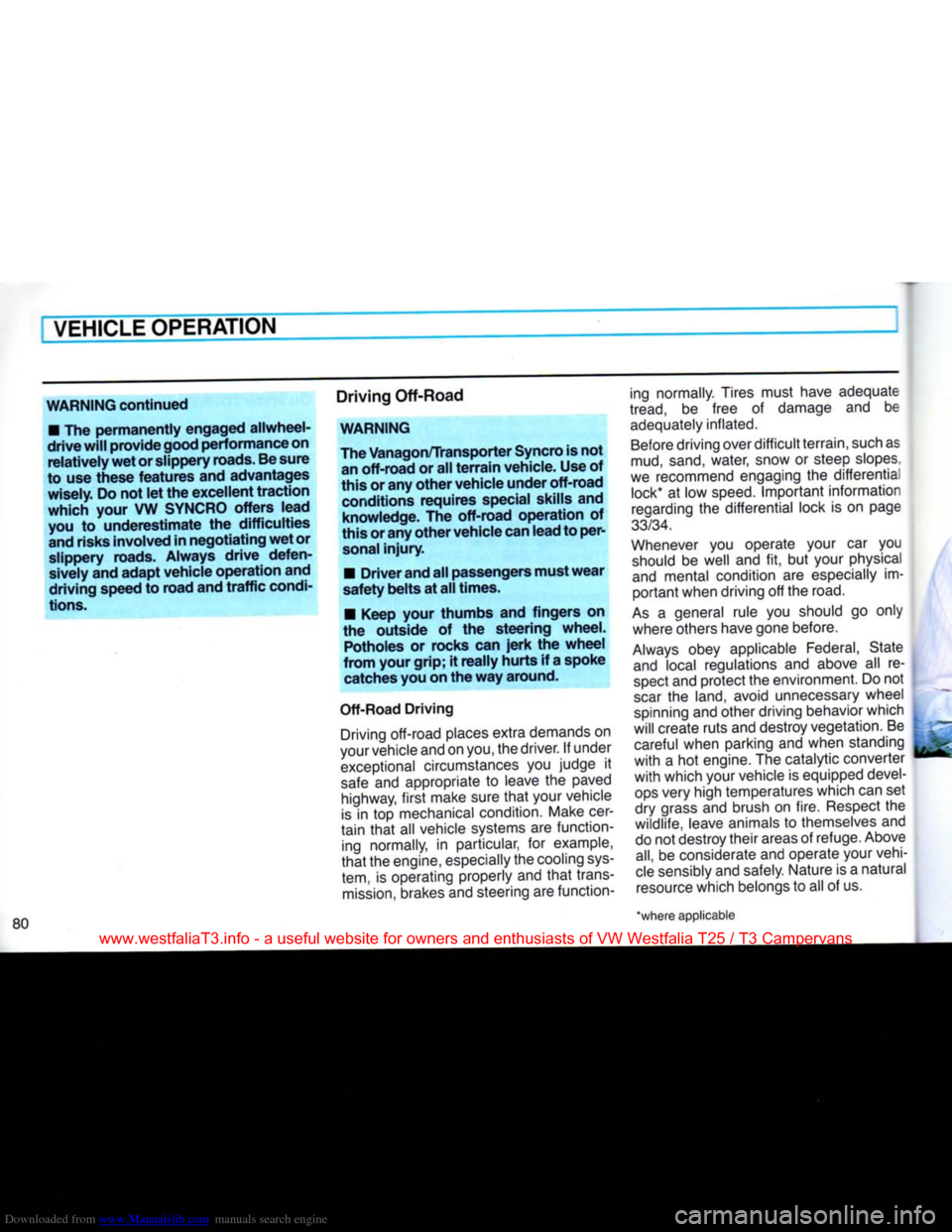
Downloaded from www.Manualslib.com manuals search engine
VEHICLE
OPERATION
WARNING continued
•
The permanently engaged allwheel-
drive
will
provide
good
performance on relatively wet or slippery
roads.
Be
sure
to use these features and advantages
wisely. Do not let the excellent traction
which your VW
SYNCRO
offers lead
you
to underestimate the difficulties
and risks involved in negotiating wet or
slippery
roads. Always drive defen
sively
and adapt vehicle operation and
driving speed to road and
traffic
condi
tions.
Driving Off-Road
WARNING
The Vanagon/Transporter
Syncro
is not an off-road or all
terrain
vehicle. Use of
this or any other vehicle under off-road
conditions
requires special skills and knowledge. The off-road operation of
this or any other
vehicle
can
lead
to per
sonal
injury.
•
Driver and all
passengers
must
wear
safety belts at all times.
•
Keep your thumbs and fingers on
the outside of the steering wheel.
Potholes
or rocks can
jerk
the
wheel
from your grip; it really hurts if a spoke
catches
you on the way around.
Off-Road
Driving
Driving off-road places extra demands
on
your vehicle and on you, the driver.
If
under
exceptional
circumstances
you
judge
it
safe
and
appropriate
to
leave
the
paved highway,
first
make sure
that
your vehicle
is
in top
mechanical condition. Make cer
tain
that
all
vehicle systems
are
function ing normally,
in
particular,
for
example,
that
the engine, especially the cooling
sys
tem,
is
operating properly and
that
trans
mission,
brakes and steering are function ing normally. Tires must have adequate
tread,
be
free
of
damage
and be
adequately inflated.
Before
driving over
difficult
terrain, such as
mud,
sand,
water, snow
or
steep
slopes,
we recommend engaging
the
differentia lock*
at low
speed.
Important
information
regarding
the
differential lock
is on
page
33/34.
Whenever
you
operate your
car you
should
be
well
and fit, but
your physical
and
mental condition
are
especially
im
portant
when driving
off
the road.
As
a
general rule
you
should
go
only where others have gone before.
Always
obey applicable
Federal,
State
and
local regulations
and
above
all re
spect
and protect the environment. Do
not
scar
the
land, avoid unnecessary wheel
spinning and other driving behavior which
will
create
ruts
and destroy vegetation.
Be
careful when parking and when standing
with
a hot
engine. The catalytic converter
with
which your vehicle
is
equipped devel
ops
very high temperatures which can set
dry grass and brush
on
fire. Respect
the
wildlife, leave animals
to
themselves
and
do not destroy their areas
of
refuge. Above
all,
be
considerate and operate your vehi
cle
sensibly and safely. Nature
is a
natural
resource
which belongs
to
all
of
us.
'where applicable
www.westfaliaT3.info - a useful website for owners and enthusiasts of VW Westfalia T25 / T3 Campervans
Page 86 of 165
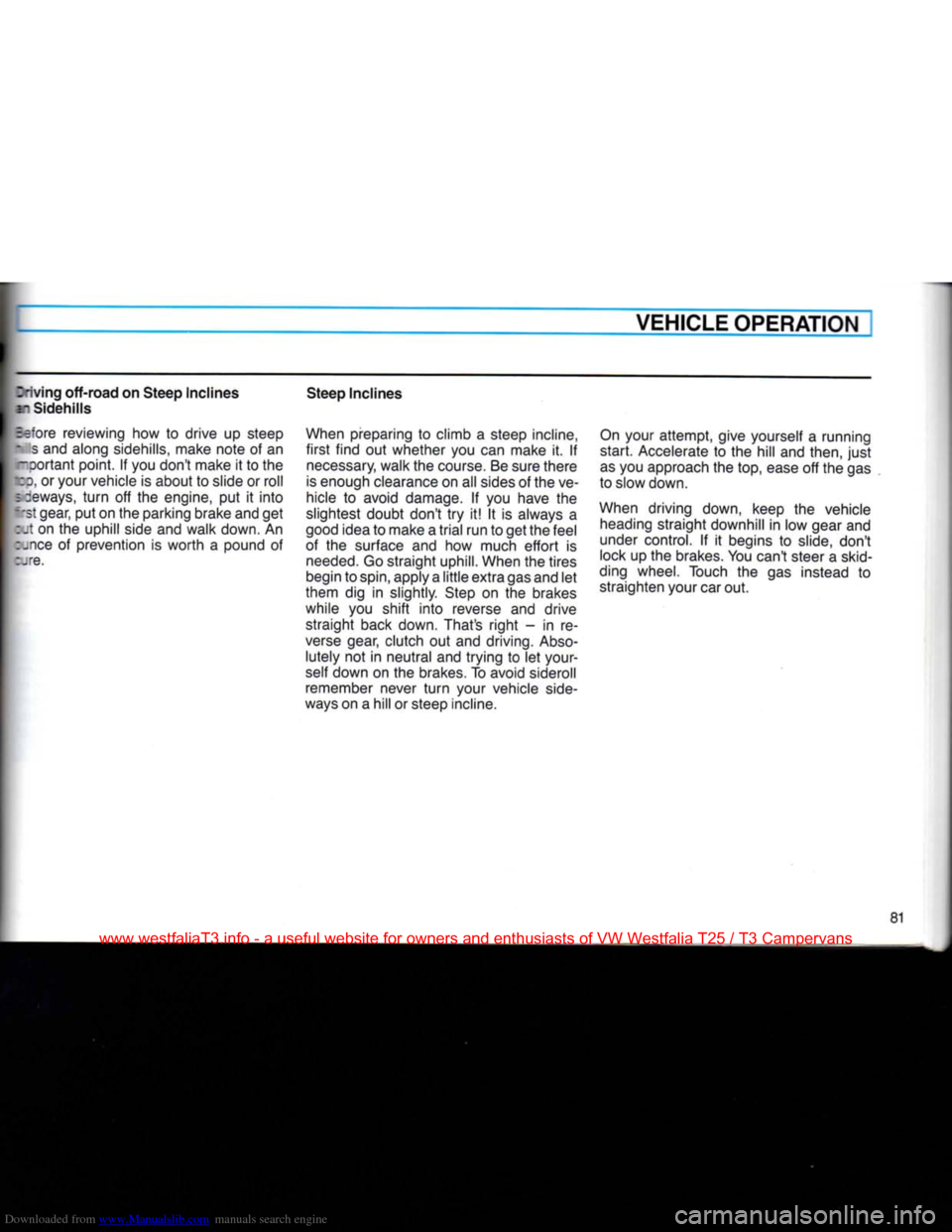
Downloaded from www.Manualslib.com manuals search engine
VEHICLE OPERATION
I'iving
off-road on Steep Inclines
I Sidehills
Before reviewing how to drive up steep
• s and along sidehills, make note of an -oortant point. If you don't make it to the
co.
or your vehicle is about to slide or roll
= :eways,
turn
off the engine, put it
into
I
'3t
gear, put on the parking brake and get
W
on the uphill side and walk down. An
:^nce
of prevention is
worth
a pound of i.re.
Steep
Inclines
When preparing to climb a steep incline,
first
find out whether you can make it. If
necessary,
walk the course. Be sure there
is
enough clearance on all sides of the ve
hicle to avoid damage. If you have the
slightest doubt don't try it! It is always a
good idea to make a
trial
run to get the feel
of the surface and how much
effort
is
needed.
Go straight uphill. When the tires
begin to
spin,
apply a
little
extra gas and let
them dig in slightly. Step on the brakes
while you shift
into
reverse and drive straight back down. That's
right
- in re
verse
gear, clutch out and driving.
Abso
lutely not in neutral and
trying
to let your
self down on the brakes. To avoid sideroll remember never
turn
your vehicle
side
ways on a hill or steep incline.
On
your attempt, give yourself a running
start. Accelerate to the hill and then,
just
as
you approach the top,
ease
off the gas
to slow down.
When driving down, keep the vehicle heading straight downhill in low gear and
under control. If it begins to slide, don't lock up the brakes. You can't steer a
skid
ding wheel. Touch the gas instead to
straighten your car out.
www.westfaliaT3.info - a useful website for owners and enthusiasts of VW Westfalia T25 / T3 Campervans
Page 87 of 165
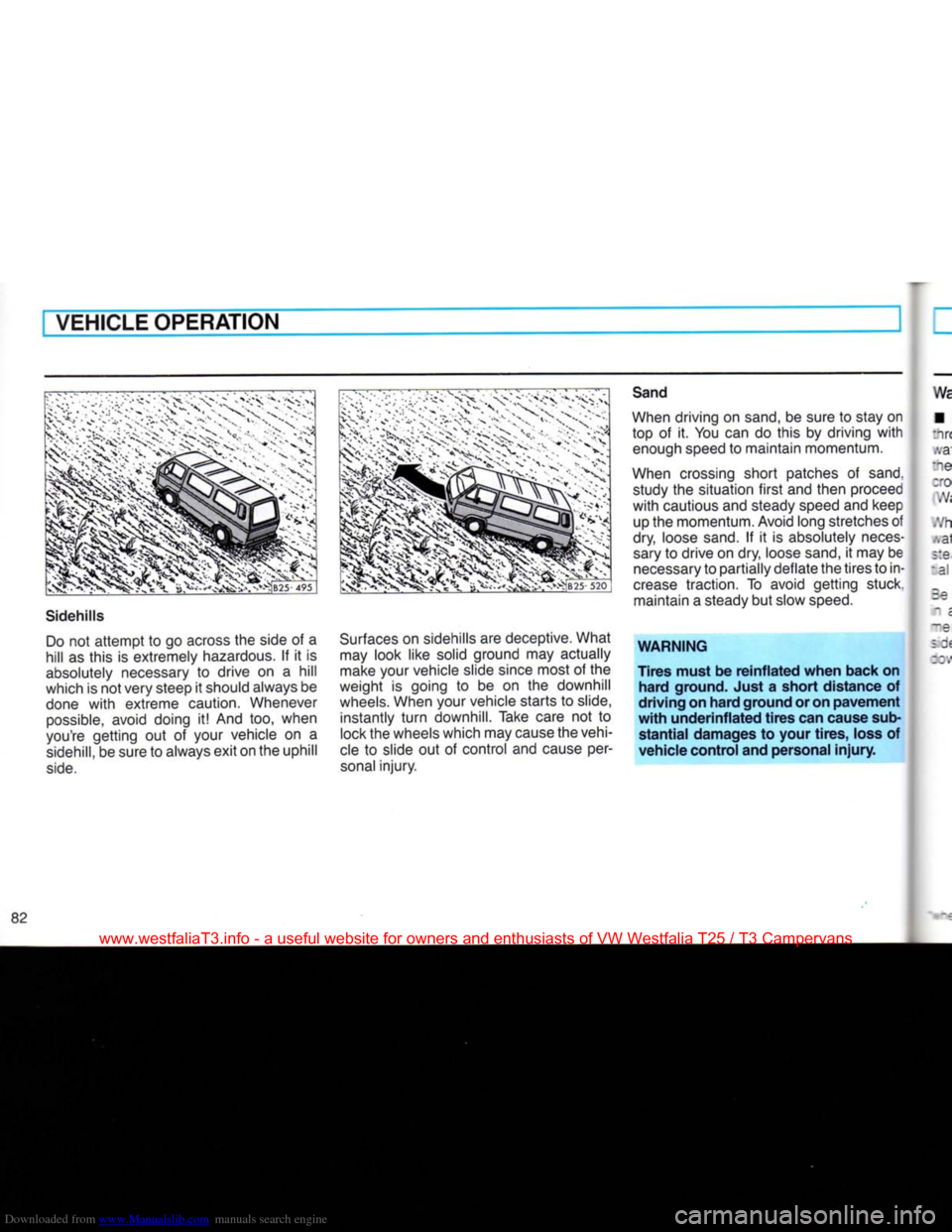
Downloaded from www.Manualslib.com manuals search engine
VEHICLE OPERATION
Sidehills
Do
not
attempt
to go across the side of a
hill as this is extremely hazardous. If it is
absolutely necessary to drive on a hill
which is not very steep it should always be
done
with
extreme caution. Whenever
possible,
avoid doing it! And too, when
you're getting out of your vehicle on a
sidehill,
be sure to always exit on the uphill
side.
Surfaces
on sidehills are deceptive. What
may look like solid ground may actually
make your vehicle slide since most of the
weight is going to be on the downhill
wheels.
When your vehicle starts to slide, instantly
turn
downhill. Take care not to
lock the wheels which may cause the vehi
cle
to slide out of control and cause per
sonal
injury.
Sand
When driving on
sand,
be sure to stay on top of it. You can do this by driving
with
enough speed to maintain momentum.
When crossing short patches of
sand,
study the situation
first
and then proceed
with
cautious and steady speed and keep up the momentum. Avoid long stretches of
dry, loose
sand.
If it is absolutely neces
sary
to drive on dry, loose
sand,
it may be
necessary
to partially deflate the tires to in
crease
traction. To avoid getting stuck, maintain a steady but slow
speed.
WARNING
Tires
must
be
reinflated
when
back
on
hard
ground. Just a
short
distance
of
driving
on
hard
ground
or on
pavement
with
underinflated
tires
can cause sub
stantial
damages
to
your
tires,
loss of
vehicle
control
and
personal
injury.
www.westfaliaT3.info - a useful website for owners and enthusiasts of VW Westfalia T25 / T3 Campervans
Page 89 of 165
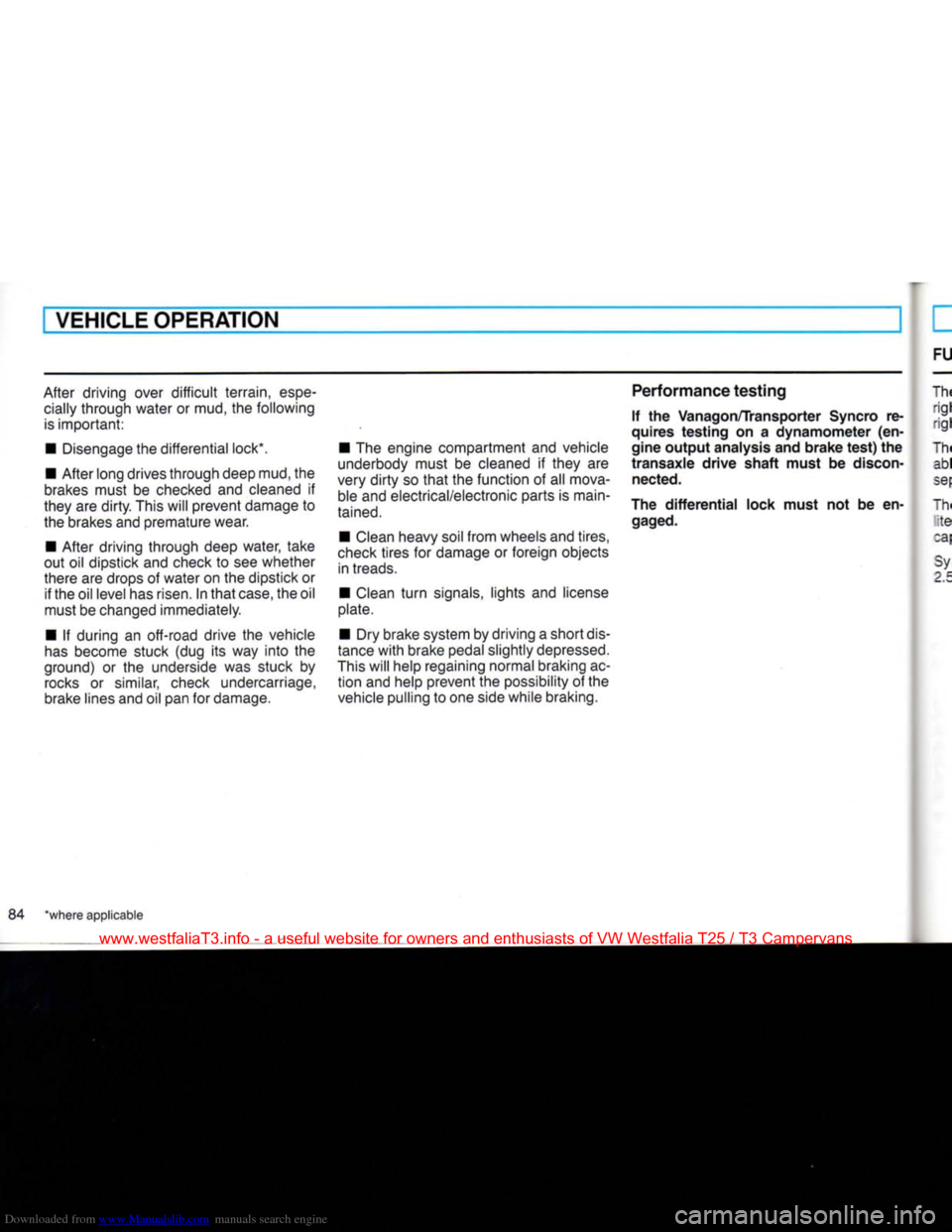
Downloaded from www.Manualslib.com manuals search engine
VEHICLE OPERATION
After driving over
difficult
terrain,
espe
cially through water or mud, the following
is
important:
• Disengage the differential lock*.
• After long drives through deep mud, the
brakes must be checked and cleaned if
they are
dirty.
This will prevent damage to
the brakes and premature wear.
• After driving through deep water, take
out oil dipstick and check to see whether
there are drops of water on the dipstick or if the oil level has risen. In
that
case,
the oil
must be changed immediately.
• If during an off-road drive the vehicle
has
become stuck (dug its way
into
the
ground) or the underside was stuck by
rocks
or similar, check undercarriage,
brake lines and oil pan for damage. • The engine compartment and vehicle
underbody must be cleaned if they are
very
dirty
so
that
the function of all mova ble and electrical/electronic parts is main
tained.
•
Clean
heavy soil from wheels and tires,
check
tires for damage or foreign objects in treads.
•
Clean
turn
signals, lights and license
plate.
• Dry brake system by driving a short dis
tance
with
brake pedal slightly depressed.
This
will help regaining normal braking ac
tion
and help prevent the possibility of the
vehicle pulling to one side while braking.
Performance
testing
If the
Vanagon/Transporter
Syncro re
quires
testing
on a
dynamometer
(en
gine
output
analysis and
brake
test)
the
transaxle
drive
shaft
must
be discon nected.
The
differential
lock
must
not be en gaged.
84 "where applicable
www.westfaliaT3.info - a useful website for owners and enthusiasts of VW Westfalia T25 / T3 Campervans
Page 90 of 165
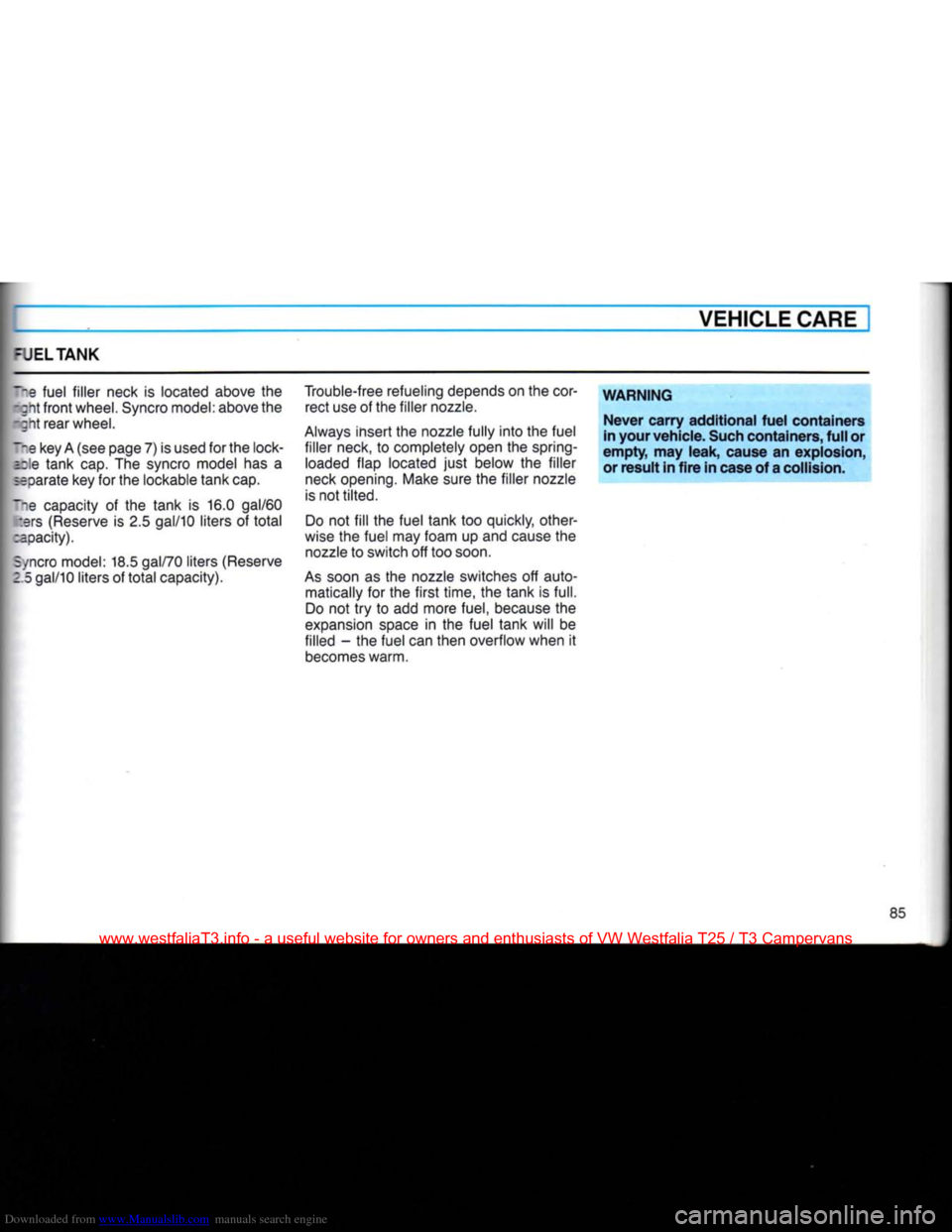
Downloaded from www.Manualslib.com manuals search engine
VEHICLE CARE
=UELTANK
|he fuel filler neck is located above the -gnt
front
wheel. Syncro model: above the
-;nt rear wheel.
mm key A (see page 7) is used for the lock-
acle
tank cap. The syncro model has a separate key for the lockable tank cap.
capacity of the tank is 16.0 gal/60
:ers
(Reserve is 2.5 gal/10 liters of
total
rapacity).
5/ncro model: 18.5 gal/70 liters (Reserve
2
5 gal/10 liters of
total
capacity). Trouble-free refueling depends on the cor
rect use of the filler nozzle.
Always
insert the nozzle fully
into
the fuel filler neck, to completely open the spring-loaded flap located
just
below the filler
neck opening. Make sure the filler nozzle
is
not tilted.
Do
not
fill
the fuel tank too quickly, other
wise the fuel may foam up and cause the
nozzle
to switch off too
soon.
As
soon as the nozzle switches off auto matically for the
first
time, the tank is full.
Do
not try to add more fuel, because the
expansion
space in the fuel tank will be
filled - the fuel can then overflow when it
becomes
warm.
WARNING
Never
carry
additional
fuel
containers
in
your
vehicle.
Such
containers,
full
or
empty,
may
leak,
cause an explosion,
or
result
in
fire
in case of a collision.
85
www.westfaliaT3.info - a useful website for owners and enthusiasts of VW Westfalia T25 / T3 Campervans